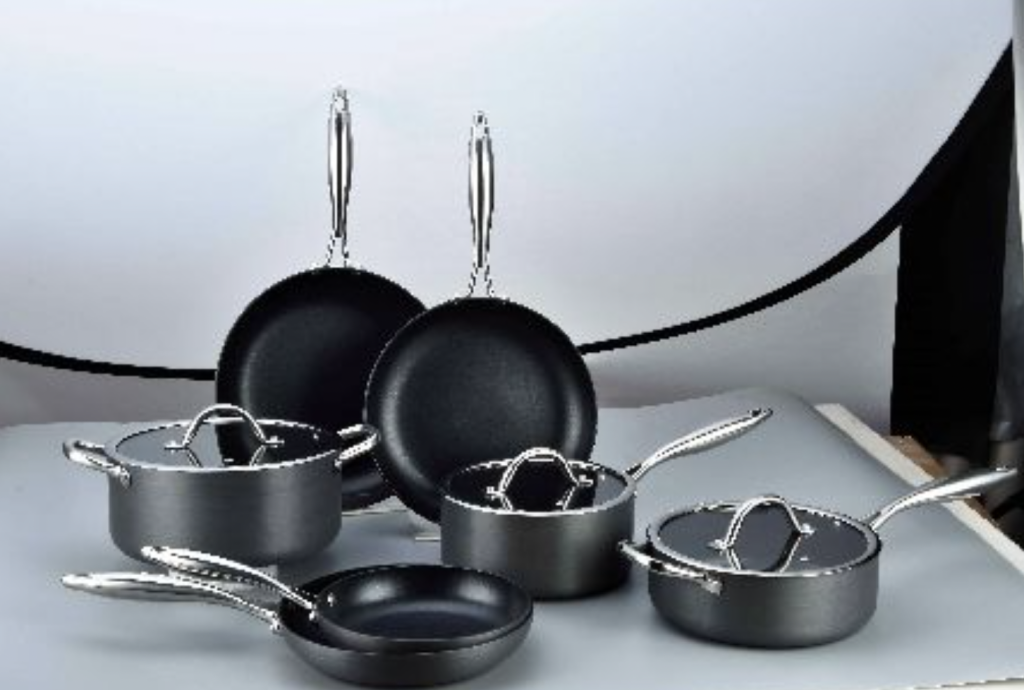Are you in the market for new cookware? If so, you may be wondering whether to choose hard-anodized or non-stick cookware. Both have their advantages and disadvantages, so it’s important to know the difference before making a decision.
What is hard-anodized cookware?
Contents
Hard-anodized cookware is made by a process of anodizing, which creates a durable, non-stick surface. This type of cookware is often used in commercial kitchens because it is so durable and easy to clean. It is also less likely to warp than other types of cookware.
The advantages of hard-anodized cookware
Some of the advantages of hard-anodized cookware include its durability, even heating, and easy cleanup. Hard-anodized cookware is made by electrochemically treating the aluminum to make it harder and more scratch-resistant. This also makes it less likely to react to food.
Hard-anodized cookware is a good choice for everyday cooking. It can be used on all types of cooktops, including induction, and can go from the stovetop to the oven. Hard-anodized cookware heats evenly, so there are no hot spots that can burn food. And, because it is non-stick, hard-anodized cookware is easy to clean.
So, if you are looking for cookware that will last a long time and is easy to use and care for, hard-anodized cookware is a good choice.
The disadvantages of hard-anodized cookware
Although hard-anodized cookware has a durable, non-stick surface, this process also makes the cookware more difficult to clean and can cause it to leach metals into food. Additionally, hard-anodized cookware is not suitable for use with metal utensils, and it is not recommended for use with high-heat cooking methods.
Some of the disadvantages of hard-anodized cookware include its high price tag and the fact that it is not suitable for use with metal utensils. Additionally, the non-stick surface can be scratched or damaged if not properly cared for.
What is non-stick cookware?
Non-stick cookware is coated with a chemical that prevents food from sticking to the surface. This type of cookware is often used for cooking delicate foods such as eggs and fish, as well as for sauces and other dishes that can be difficult to clean up. Non-stick cookware is also convenient because it doesn’t require the use of cooking oils or butter, which can save you calories.
The advantages of non-stick cookware
Non-stick cookware has become increasingly popular in recent years, as it offers a number of advantages over traditional cookware. Non-stick cookware is coated with a special coating that prevents food from sticking to the surface of the pan or pot, making it much easier to cook with and clean up afterward. In addition, non-stick cookware is often made with lighter materials that make it easier to handle, and it can be used on a variety of cooking surfaces, including gas and electric stovetops.
One of the biggest advantages of non-stick cookware is that it eliminates the need for oil or butter when cooking. This not only makes the cooking process healthier but also cuts down on the time and effort required to prepare a meal. Non-stick cookware is also very easy to clean, as the food simply slides off the surface. This means that there is no need to scrub or soak the pan in order to get it clean.
If you are considering switching to non-stick cookware, it is important to choose a quality product that will last. Look for cookware that is made with durable materials and has a good non-stick coating. Avoid cheaper products that may not offer the same level of performance or durability. With a little research, you can find the perfect set of non-stick cookware to meet your needs and help make your cooking experience more enjoyable.
The disadvantages of non-stick cookware
Non-stick cookware has a number of disadvantages. Firstly, it is more expensive than traditional cookware. Secondly, it is not as durable as traditional cookware and can easily be scratched or damaged. Thirdly, non-stick cookware can release harmful chemicals into food when it is heated to high temperatures. Finally, non-stick cookware is not suitable for use in the oven as it can discolor or warp.
How to make the best choice?
When it comes to cookware, there are many different options available on the market. Two of the most popular choices are hard-anodized and non-stick cookware. So, how do you know which one is right for you? Here are a few things to consider that will help you make the best decision for your needs.
Hard-anodized cookware is made by electrochemically treating the surface of the metal to make it harder and more durable. This type of cookware is often used in commercial kitchens because it can withstand a lot of wear and tear. It is also a good choice for home cooks who do a lot of cooking at high temperatures, such as stir-frying or deep-frying.
Non-stick cookware is coated with a substance that prevents food from sticking to the surface of the pan. This makes it a good choice for cooking delicate foods, such as fish or eggs, that might stick to and break apart on other types of surfaces. Non-stick cookware is also a good choice for home cooks who want to avoid using a lot of oil or butter in their cooking.
Now that you know a little bit more about hard-anodized and non-stick cookware, you can make an informed decision about which type is right for you. Consider the types of foods you like to cook, the amount of cooking you do, and your budget when making your decision. With so many great options available, you are sure to find the perfect cookware for your needs!

